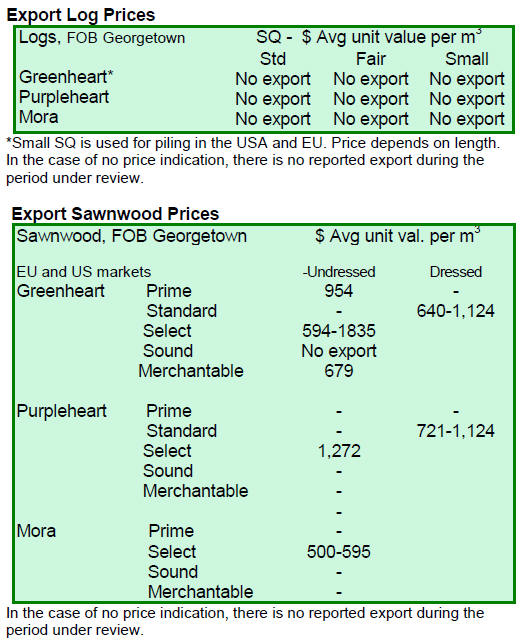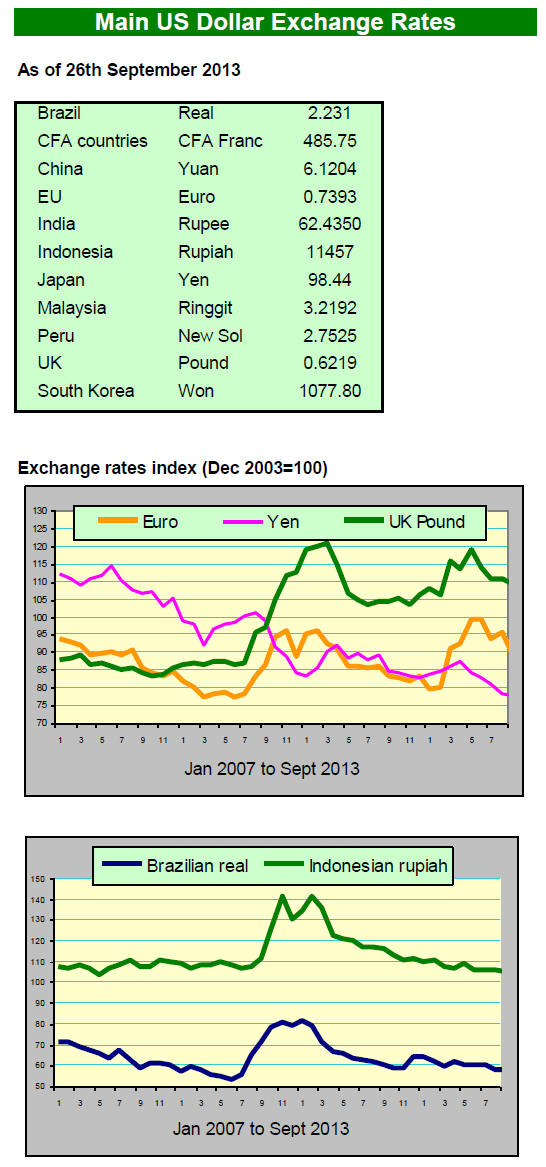2. GHANA
Huge increase in water and electricity
prices
Manufacturing and trading costs will increase as utility
prices are set to increase by a huge margin. Charges for
water are set to rise 52% and charges for electricity will
jump a massive 79%.
These increased were announced by the Public Utility and
Regulatory Commission (PURC), in Accra, which has
been engaging stakeholders in discussions on tariff
changes over the past few months.
Nana Yaa Gyantuah, the Director of Public Affairs at the
PURC confirmed that tariffs "are definitely going up".
A previous tariff increment was put on hold because of a
nationwide power load shedding exercise that plagued the
country.
The increase in utility tariff is attributed to the high
dependence on crude oil to generate power compared to
gas. Unfortunately Ghana has not been able to access gas
resources from the stalled West African Gas Pipeline
project.
The last time utility rates were increased was in 2010 but
still many in Ghana have condemned the rate increase
saying it will be hard for the average Ghanaian family to
absorb such an increase.
Helping the younger generation appreciate role of
forests
A Senior Lecturer at the Kwame Nkrumah University of
Science and Technology (KNUST), Dr Ernest Asare
Abeney, has called on stakeholders in the forestry sector to
partner civil society organisations to promote sustainable
forest management practices in the country.
According to Dr. Abeney the destruction of Ghana‟s
forests could be attributed to the lack of adequate
education on forestry laws and policies because, he says,
most Ghanaians were not aware of the impact of forestry
on national wellbeing.
Speaking at a press briefing in Accra, Dr Abeney, said
¡°since the forestry sector contributes substantially to the
development of the country‟s economy there is the need
for Ghanaians to be informed and educated to desist from
negative practices that affect forests.¡±
He also underscored the need for the Ghana Education
Service to include forest protection in educational
programmes to inform the younger generation on forest
protection issues.
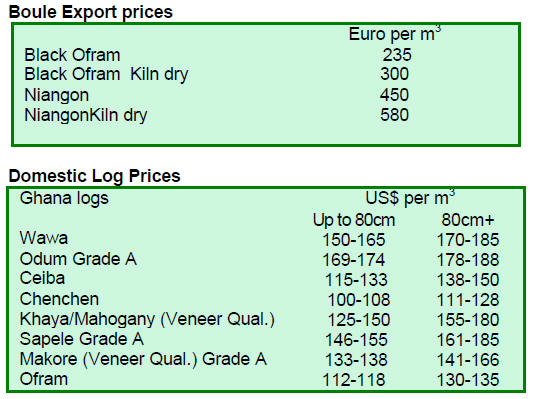
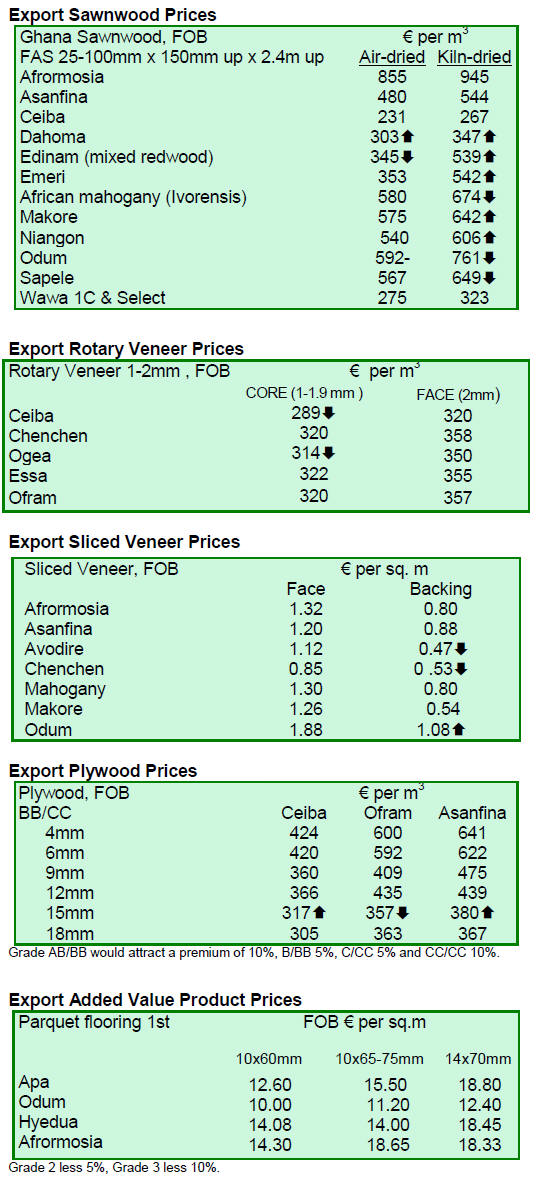
¡¡
3. MALAYSIA
Government and industry identify
challenges in the
timber sector
The plantation and commodity sector is a major income
earner for Malaysia, having brought in RM 127.5 billion in
2012, or around 18% of all total exports.
The National Timber Industry Policy which was launched
in 2009 envisioned yearly earnings of RM 53 billion
(about US$16.2 billion) by year 2020 from the timber subsector
alone.
Recently representatives of the Ministry of Plantation
Industries and Commodities, which is responsible for the
timber industry in Malaysia, met with industry
associations and representatives to discuss issues they
faced.
The issues that are common to the various sub-sectors of
the timber industry are the importance of foreign workers
in the processing plants, the impact of the new minimum
wage policy on competitiveness, the shortage of raw
materials and increasing operational costs.
Online MYTLAS license applications
The timber industries in Malaysia have been working hard
to meet the requirements of the recently introduced
Malaysian Timber Legality assurance Scheme
(MYTLAS). The Malaysian Timber Industry Board
(MTIB) is supporting the efforts of industry and has a
website to facilitate online applications for the MYTLAS
license.
The MTIB website is designed to accommodate
application for all categories of timber products. When the
MYTLAS conditions have been satisfied a license is
generated at the same time as the compulsory MTIB
export license.
Although furniture exporters do not need an export license
they can obtain the MYTLAS license on the MTIB
website. The issuance of a MYTLAS license is subject to
physical inspection of the furniture consignment by MTIB.
A copy of the MYTLAS brochure is available at this
MTIB site:
http://www.mtib.gov.my/index.php?option=com_content
&view=article&id=2142%3Abrochure-mytlas-yourassurance-
of-legal-timber-frommalaysia&
catid=1%3Ahighlights&lang=en
Port facilities in Sabah to be upgraded
The government agency operating ports in Sabah, Sabah
Ports Sdn Bhd, has announced plans to spend RM229
million (about US$70 million) over the next two years to
improve port infrastructure and equipment.
Sabah Ports plans to expand berthing facilities at
Sandakan Port and the Sapangar Bay oil Terminal. After
completion of the jetty extensions these two ports will
have additional berthing facilities thus eliminating the risk
of congestion.
Sabah Ports has also increased the fleet of container
handling equipment at Sepangar Bay Container Port,
Sandakan Port and Tawau Port. By the end of this year,
Lahud Datu Port will also have additional transfer and
yard equipment.
Moreover, Sabah Ports will acquire a new mobile harbour
crane for Sandakan Port in addition to the existing crane to
further improve the loading and discharging of containers.
Meanwhile, ongoing studies by Sabah Ports will look at
further improving port services in Sabah.
Sarawak minister calls for review of tax
deductions
The Sarawak, Industrial Development Minister, Awang
Tengah Ali Hasan, has appealed to the Federal
government to introduce a double tax deduction on freight
charges as the high freight charges for both inbound and
outbound goods have always been seen as a burden to
businesses in Sarawak.
The local newspaper, Borneo Post, reported the latest call
was aimed at three categories of trade saying the double
deductions should cover sales of products by all industries
to Peninsular Malaysia and Sabah; purchases of raw
materials from Peninsular Malaysia for manufacturing of
products specifically for export and the transportation
costs within the state of Sarawak.
The minister said double tax deductions would help local
business compete on a level playing field with their
counterparts in Peninsular Malaysia and ultimately make
Sarawak products more competitive in world markets.
Malaysian industry to visit Vietnam wood Expo
The Malaysian Timber Council (MTC) is organising a
Technology Study Mission to Vietnam on 23 ¨C 27
September 2013.
The Mission aims to provide Malaysian wood product
manufacturers with exposure to the latest developments in
woodworking and wood processing technologies. The
Mission will also provide opportunities for trade and joint
ventures with Vietnamese companies.
The itinerary will include visits to the 10th Vietnam
International Woodworking Industry Fair (Vietnamwood),
which will be held at the Saigon Exhibition and
Convention Center. In addition to the fair the Malaysia
delegates will tour woodworking factories in the vicinity
of Ho Chi Minh City to observe the application of
advanced technology.
Learning from New Zealand¡¯s experience in plantation
management
The Sarawak Timber Association (STA) is organising a
trip to New Zealand for its members involved in tree
plantations. STA general manager Dr. Peter Kho said
New Zealand was chosen because it has the most
extensive experience in industrial forest plantation
establishment.
The New Zealand Forest Owners Association says
members manage around two thirds of the country‟s 1.79
million ha. planted forests.
Dr. Kho told the Star newspaper, ¡°We will be meeting
industry players and will participate in field trips to the
forest plantations to see how they manage the plantations¡±.
STA has collaborated with New Zealand experts for over
15 years, especially in training of tree fellers and forest
managers.
4. INDONESIA
Long struggle culminates with VPA signing
Indonesia has moved a step closer to becoming one of the
first suppliers of timber licensed as legal under the EU
Forest Law Enforcement Governance and Trade Action
Plan (FLEGT).
In a press release the European Timber Trade Federation
(ETTF) said the Indonesian signing of a VPA is a big step
toward FLEGT-licensed timber delivery. The press release
goes on to say: ¡°When available, this will satisfy the
requirements of the EU Timber Regulation (EUTR)
without additional due diligence risk assessment.
On Monday 30th September Indonesia‟s Forestry Minister
Zulkifli Hasan and EU Environment Commissioner Janez
Potočnik sign the country‟s FLEGT Voluntary Partnership
Agreement (VPA).
This marked the culmination of six years‟ work, from the
start of its VPA negotiations, to establish a watertight
forestry and timber legality assurance framework that
meets the parameters of the EU anti-illegal timber FLEGT
initiative.
Central to the process has been the establishment of
Indonesia‟s definition of illegal timber. It has also had to
set up a legality assurance system (LAS), and associated
licensing, auditing and monitoring mechanisms and
organisations, with the input of as wide a range of
stakeholders as possible.
Next Indonesia and the EU have to ratify the VPA, which
covers a specific list of named timber and wood products,
into their respective laws. Both must be then be finally
assured that the LAS is up to the task, before the listed
goods can enter the EU as FLEGT-licensed and,
subsequently, automatically legal under the EUTR.
No definitive deadlines have been set, but the hope is that
Indonesia will start issuing FLEGT licenses in 2014.
ETTF members also looked forward to the next stage ¨C the
delivery of Indonesian FLEGT-licensed timber. ¡°That is
of utmost importance to importers, given that it will
provide them with a supply of timber considered legal
under the EUTR without further due diligence,¡± said Mr
de Boer, Secretary General of the ETTF.¡±
Private sector ready for forest restoration in Riau
A major pulp and paper company in Indonesia is about to
begin work to restore a degraded peat forest in Sumatra.
Restorasi Ekosistem Riau (RER), a non-profit organization
started by Asia Pacific Resources International Limited
will conduct work to rehabilitate 20,000 hectares of land
in the southeastern part of Riau‟s Kampar Peninsula.
RER secured an ecosystem restoration license from the
Ministry of Forestry early this year.
For more on this story see:
http://www.thejakartaglobe.com/news/april-prepares-newforest-
restoration-project-in-riau/
Green-house gas emission technology transfer
improved
The Tropical Forest Foundation has reported that
Indonesia and Japan have agreed to ways to speed up the
processing of deals through which Japanese companies
can assist Indonesia reduce greenhouse emissions through
improved technology and conservation schemes.
A joint crediting mechanism (JCM) has been agreed where
by the two countries will cut out intermediaries in
greenhouse-friendly technology transfer, investment,
financing and capacity building.
Under the Kyoto Clean Development Mechanism
protocol‟s the United Nations must approve any such
investment but it has been found the UN process is too
slow requiring a lengthy screening process.
Under the new agreement, the Japanese government will
conduct feasibility studies to secure carbon emission
reductions in Indonesia through renewable energy,
forestry, energy conservation, agriculture, transportation,
carbon storage and waste treatment.
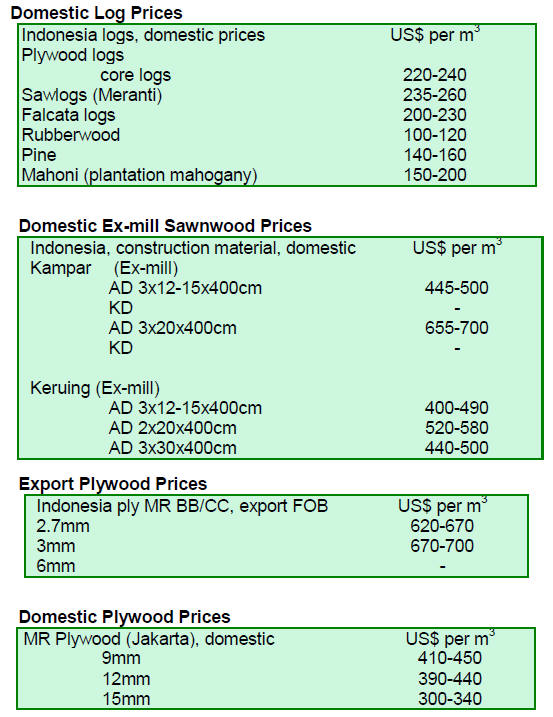
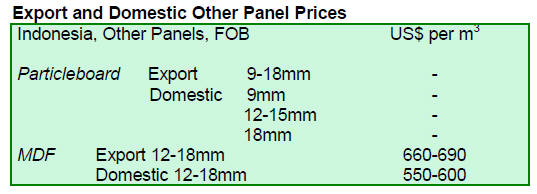
¡¡
5. MYANMAR
Teak sales quiet as Indian buyers remain
on the
sidelines
The overall impression in the market is that demand
remains as sluggish as last month with no clear direction.
The Indian market is still reeling from the effects of the
sharp depreciation of the rupee and this has un-nerved
Indian buyers who are taking a wait and see stance even
though the rupee has appreciated to 62 to a dollar in the
past week.
The uncertainty in the trade over the impending log export
ban coupled with the volatile rupee exchange rate is
having a big impact on sentiment in the trade and will
determine the level of shipments in the coming months.
Corporate governance principles MTE discussed
Timber Trade Journal of September 21 -27 mentioned an
email Q&A with Union Minister for Environmental
Conservation and Forestry (MOECAF) U Win Tun on the
subject of the Myanma Timber Enterprise (MTE)
corporatisation.
Minister Win Tun explained that, at this point in time, it
was envisaged that MTE will remain a 100% state-owned
corporation and that there are no immediate plans to
transform it into a public company.
Regarding „Corporate Governance‟, the minister
mentioned that the principles and guidelines as practised
in OECD and non-OECD countries were being examined
and that Myanmar needs more experience to adjust to
internationally recognised corporate governance standards.
The minister indicated that instead of directly adopting
principles and guidelines for corporate governance in
OECD countries the situation in Myanmar would be
assessed and appropriate principles would be adopted and
people would be trained accordingly.
He further spoke on the need for „ethical behaviour‟
amongst management but mentioned it would take time to
convert this concept into a „culture‟ in the MTE.
The indications are that MTE will be state-owned and the
management and the Board of Directors would be
personnel representing state interests, professionals and
those that have in mind the welfare of the country.
Even though a restructuring was in the offing, the minister
said, the present officers of the MTE would form the new
management but, as in a private company, they would be
required to execute the function of MTE in a competent
manner to create an atmosphere of efficient
commercialisation.
Foreign investment in Myanmar
Myanmar introduced a revised foreign investment law in
2012 and the Mizzima News, quoting local media,
reported that Myanmar attracted over US$731 million in
foreign investment during a single month bringing
investment to the end of August to US$43 billion since
1988.
For the year up to August, China has invested US$14.2
billion, Hong Kong SAR US$6.5 billion, South Korea
US$3 billion, Singapore US$2.4 billion dollars, Malaysia
US$1.6 billion and Japan US$274 million.
US$150 million to address chronic power shortages
In related news, the World Bank is lending Myanmar
almost US$150 million to help alleviate the country's
chronic power shortages.
In a press release the bank said ¡°the World Bank Group
and Myanmar reinforced their commitment to grow the
economy, create jobs and reduce poverty through
accelerated reforms and a focus on energy infrastructure
development¡±.
See: http://www.worldbank.org/en/news/pressrelease/
2013/02/05/World-Bank-Group-to-Support-
Myanmar-8217-s-Plan-to-Improve-People-8217-s-Accessto-
Electricity
A recent delegation to Myanmar agreed to support a
request for urgent upgrading of the electric power capacity
and improvement of the telecommunications and banking
sectors. The bank said a 106 megawatt plant will provide 5
percent of peak power demand for the entire country and
50 percent of peak demand in Mon state.
The press release says the Bank is providing Myanmar
with US$165 million in zero-interest loans for its priority
needs. This is in addition to a US$80 million grant for
community driven development that will enable villagers
to improve schools, clinics, roads and water supply.
The International Finance Corporation, member of the
World Bank Group focused on private sector development
in emerging markets, has invested US$2 million in
ACLEDA Bank Plc to help set up a new microfinance
institution in Myanmar to provide loans to more than
200,000 people ¨C mostly micro and small businesses run
by women ¨C by 2020.
Teak tender prices
The following prices were recorded for teak log sales
during competitive bidding on 27th and 30th September
during the MTE tender.
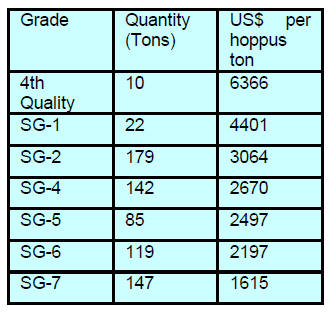
¡¡
6.
INDIA
Indian economy and Rupee back from the
brink
In a remarkable short time the signs are that the recent
uncertainty in the Indian economy have dissipated. The
encouraging signs in overseas demand and in domestic
consumption have brought cheer to an otherwise cheerless
industry.
The abrupt depreciation of the rupee has been halted and
the currency has clawed back from a historic low of 68.85
to the US dollar on August 28 to 62.30 to a dollar on
September 23. Analysts expect the rupee to strengthen
further to around Rs.60 to the dollar.
Double digit growth of exports and reduced imports has
narrowed the trade deficit. Exports surged 13% in August
2013 compared to levels in August last year and exports of
wood products registered an even higher year on year
growth of 18% from April to July.
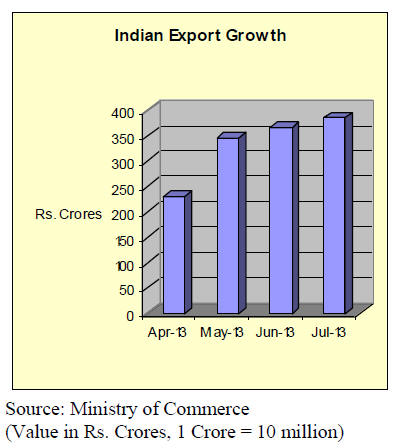
The current account trade deficit narrowed to
US$10.9
billion in August from $14.2 billion a year ago. There are
plans to raise import duties on a range of non-essential
items which will bring the deficit down further.
In other news, industrial output in July improved
marginally by 2.6%, up from the 1.8% growth in June.
Few cities benefit from flow of overseas funds
property market
Despite the steadying of the economy the real estate sector
is still feeling the impact of the recent domestic crisis.
Indians living and working overseas have taken advantage
of the depreciated rupee to bring foreign exchange home
and buy property. The flow of remittances has been high
in recent weeks.
Analysts report that this new money has flowed to the real
estate sector in just for of 26 major cities and has had the
effect of pushing up prices. However, in the other 22
major urban areas home prices have declined and
expectations are that it will take at least another six
months for prices to correct.
According to the property research firm Liases Foras
around 670 million square feet of housing stock is lying
unsold. Demand has been hit by high inflation, increased
costs of basic raw materials such as cement, steel, sand etc
and also because of job cuts in several sectors which has
undermined consumer confidence.
New building projects are not likely to begin any time
soon especially as the festive season is just around the
corner. Developers are now resorting to offering discounts
and innovative payment structures to stimulate sales to
reduce the unsold inventory.
Plantation teak imports
With the economic situation improving the pace of
imports will eventually resume but traders remain cautious
fearing further shocks. Analysts report there are sufficient
teak in transit and at the ports to meet the immediate needs
of industry.
Current C & F prices for imported plantation teak, Indian
ports per cubic metre are shown below.
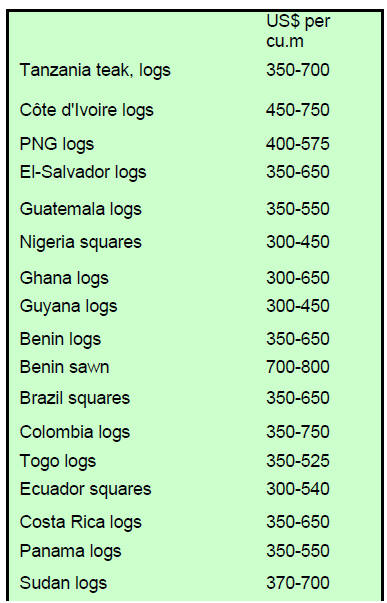
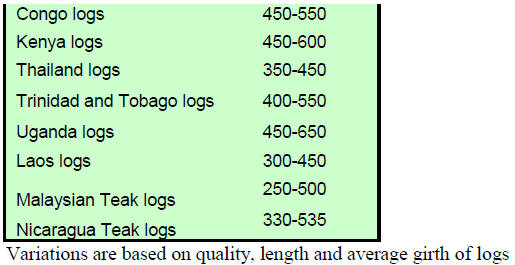
Domestic ex-sawmill prices for air dried
sawnwood cut
from imported logs
Prices per cubic foot are shown below.
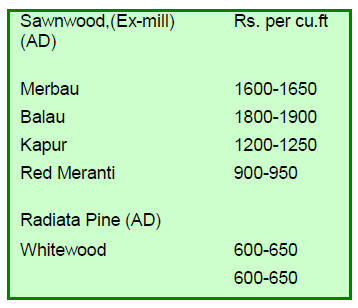
Domestic prices for Myanmar teak processed in India
The effects of higher log landed costs are now reflected in
prices being quoted for Myanmar logs sawn by Indian
mills. Current prices are shown below.
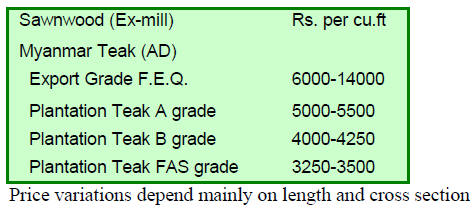
Prices for imported sawnwood
Ex-warehouse prices for imported kiln dry (12% mc.)
sawnwood per cu.ft are shown below.
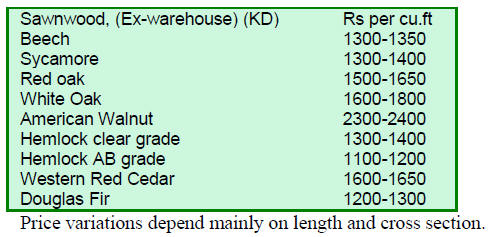

7.
BRAZIL
Interest rates raised to address
inflation
Brazil.s Consumer Price Index (IPCA) at 0.41% was up
0.24% in August after increasing 0.03% in July.
With the August result, the IPCA has increased 3.43% for
the year to August. In the same period last year, the
cumulative inflation for the year was 3.18%.
The average exchange rate in August 2013 was BRL 2.34
to the dollar while in the same month of the previous year
was BRL 2.03 signaling a sharp depreciation of the
Brazilian real against the US dollar.
Largely because inflation needs to be tamed a decision
was taken to raise the interest rate (Selic) by 0.5% at the
Central Bank meeting held at the end of August. This
brings the interest rate to 9% per year. This was the fourth
consecutive interest rate increase so far this year. Since
April the rate has climbed from 7.25%, the lowest
historical level, to 9%.
Concession bidding opens in Altamira National Forest
The Brazilian Forest Service (SFB) has recently concluded
the bidding process for concession harvesting rights.
The latest areas offered include forest areas in the
Altamira National Forest (FLONA). Bids remain open for
around 740,000 hectares areas in the FLONAS of Amana,
Crepori, and Saraca Taquera in the state of Para.
So far there are more than 1 million hectares of FLONAs
in the Amazon are under forest concession management.
In addition to the production of timber whose origin can
be traced forest concessions create jobs, investment and
increase incomes for local administrations.
The Altamira FLONA has 360,000 hectares, divided into 4
forest management units that range from 39,000 and
113,000 hectares. In the bidding process companies are
required to submit two different proposals, one technical
and the price offer per cubic metre. Stumpage prices range
from BRL 21 and 42 per cubic metre.
Furniture sector expects increased sales towards year
end
Despite the slump in furniture sales in the second quarter
of 2013 the Brazilian furniture industry anticipates that
sales will begin to expand towards year end so that, overall
2013 sales could be up by 4%.
The furniture industry in Brazil faces many challenges
such as high transaction costs, high inflation, high labour
taxes and high logistics costs. An additional problem faced
by the industry is skilled labour. Even when sales dip
seasonally companies are reluctant to lay off their
employees because they are highly skilled and it is
difficult to find skilled and qualified manpower.
The furniture sector believes that there will be a seasonal
increase in orders starting this month because the retail
sector starts ordering furniture in anticipation of the end of
year increase in demand. Normally a one or two percent
rise in sales can be expected but the recent easing of credit
restrictions could lift sales.
August export data has no surprises
In August wood products exports (except pulp and paper)
fell 4.6% compared to values in August last year, that is
from US$ 213.2 million to US$ 203.4 million.
Pine sawnwood exports increased 8.9% in value in August
2013 compared to August 2012, from US$13.5 million to
US$14.7 million. In terms of volume, exports rose 5.5%,
from 61,300 cu.m to 64,700 cu.m.
In contrast tropical sawnwood exports fell 6.3% in
volume, from 28,500 cu.m in August 2012 to 26,700 cu.m
in August 2013 representing a decline of 2.0% in value
from US$14.7 million to US$ 14.4 million.
Pine plywood exports expanded 8.6% in value in August
2013 compared to August 2012, from US$30.4 million to
US$33.0 million. In terms of volume, exports increased
11.4% from 82,200 cu.m to 91,600 cu.m.
Tropical plywood exports were disappointing falling 7.0%
in volume, from 5,700 cu.m in August 2012 to 5,300 cu.m
in August 2013. In value, tropical plywood exports
fell16%, from US$3.7 million in August 2012 to US$3.1
million in August 2013.
At the same time wooden furniture exports dropped from
US$47.7 million in August 2012 to US$41.4 million in
August 2013, a 13.2% decline.
Rio Grande do Sul State maintains leadership in
furniture exports
In the first seven months of the year furniture exports grew
substantially, fueling optimism for the remainder of this
year and for next years‟ sales.
The state of Rio Grande do Sul still ranks first among the
states that export furniture with over US$111 million
traded for the year to July. This represents about a 28%
share of Brazilian furniture exports up to the end of July.
The major markets for Brazilian furniture are the United
Kingdom, (US$16.2), representing a 28.4% increase
compared to the previous year. Other major markets
included Uruguay (US$14.4 million), Peru (US$12.3
million), Chile (US$11.3 million) and the United States
(US$7.8 million).
In an increasingly competitive market, Brazilian furniture
manufacturers have demonstrated their entrepreneurial
talent to overcome domestic constraints such as high
labour taxes and high logistical costs. The weakening of
the real has contributed to the success of exporters.
Calls for increased automation to improve productivity
Sawnwood products prices are currently high in the
international market since the international economic
crisis in 2008.
The favorable moment in the international scenario has
motivated the timber sector, which is searching for
solutions to increase productivity.
As international demand for sawnwood is beginning to
grow the timber industry in Brazil has begun to look at
ways to improve productivity so as to be more
competitive.
In mid September the Federation of Industries of Parana
State in partnership with the Brazilian Association for
Mechanically Processed Timber brought millers together
to discuss measures to increase productivity.
The main conclusion from the meeting was that further
mechanisation is essential if productivity is to be raised. It
was agreed that the timber industries are too labour
intensive at a time when it is very difficult to find skilled
manpower.
Recently the level of mechanisation has increased but
automation is still something new which, the meeting
decided, must be addressed. Participants at the meeting
appreciated the quality of information exchanged during
the discussions considering this fundamental to address
production constraints.
Price movements
The average price of timber products in BRL did not show
variation from the previous fortnight.
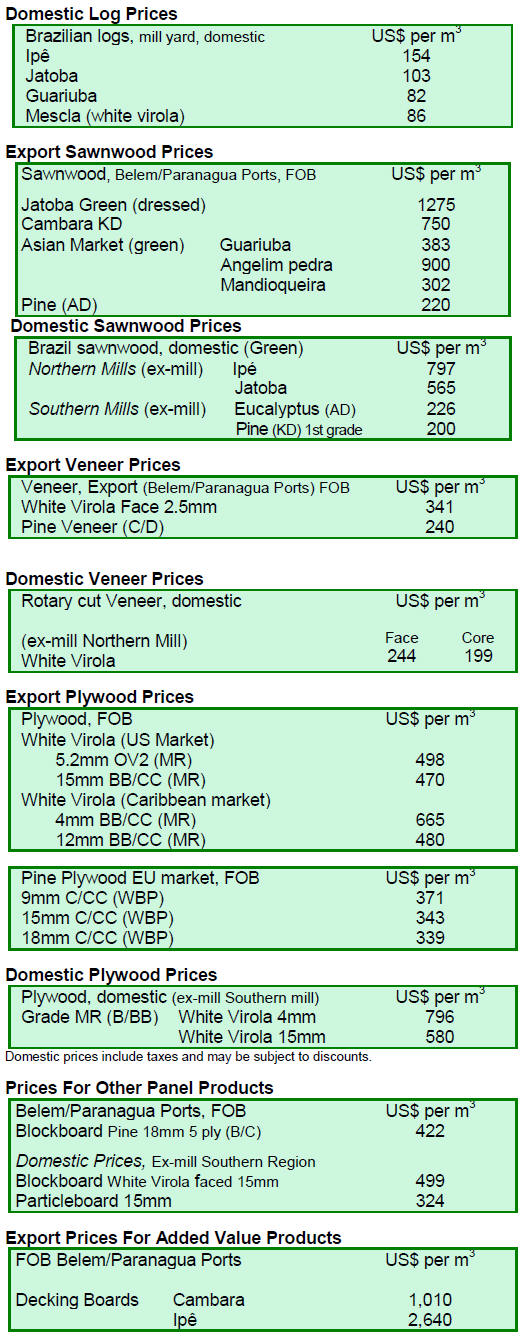
8. PERU
APEC Ministers discuss role of
forests in improving
quality of life
The second APEC Ministerial Forestry Forum was
recently held in Peru. The main theme of this meeting was
how forests can contribute more to an improved quality of
life.
The 21 APEC countries possess 53% of the world's
tropical forests and are responsible for 80% of
international forest products. The APEC meeting was held
just after the government passed into law forestry and
wildlife regulations to regulate the use of forest resources.
China ready to support reforestation in Peru
Media reports are saying China has expressed a
willingness to contribute resources and cooperate with
Peru in projects related to reforestation and sustainable
management of forests.
Zhang Yongli of China‟s State Forest Administration said
that this is possible because there is a memorandum of
understanding between the two countries which includes
bilateral cooperation in regard to the sustainable
management of forests, wildlife protection and
biodiversity conservation.
Only 12% of potential commercial forests currently
utilised
Erik Fischer, chairman of Wood and Timber Industry
ADEX, said that the country has 17 million hectares of
forest suitable for commercial forestry but of this less than
2 million hectares are in production.
He said further that of the 600 plus concessions that have
been offered or granted only 80 are operating effectively.
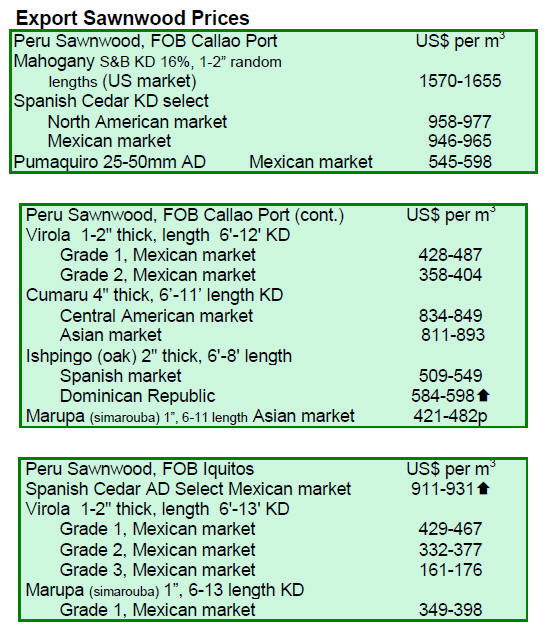
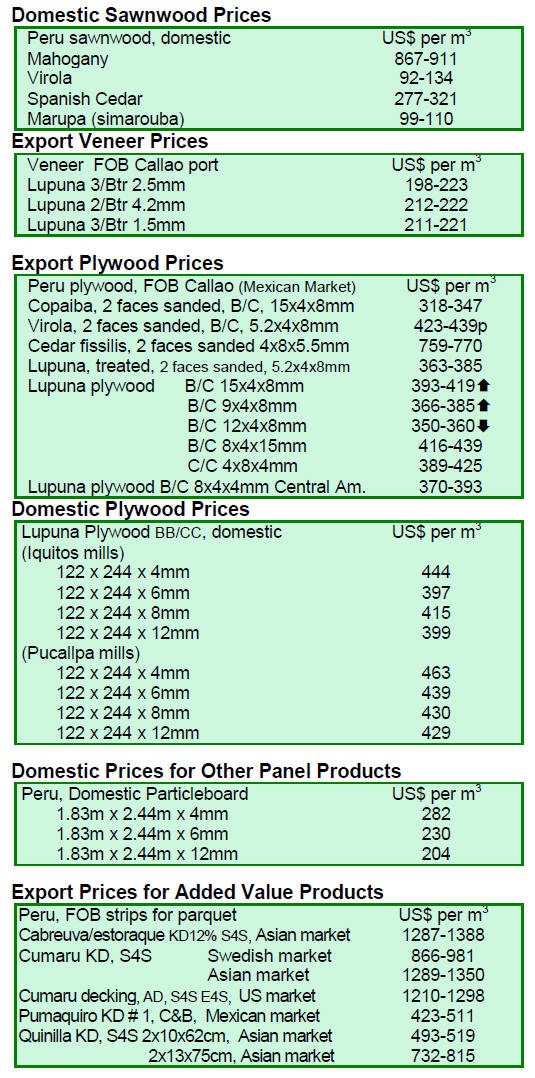
9.
GUYANA
Sawnwood alone providing export earnings
There were no exports of the main commercial species in
the period under review. However the wamara (Swartzia
leiocalycina) logs made an impact on the export market
attracting favourable prices as much as US$160 per cubic
metre in Asian markets.
Sawnwood exports continued and both Undressed (rough
sawn) Dressed categories were traded. Undressed sawn
greenheart attracted an average price of US$954 per cubic
metre FOB for prime category.
On the other hand the select category Undressed sawn
greenheart secured a top end price of US$1,835 per cubic
metre FOB, while merchantable quality prices held firm at
US$679 per cubic metre FOB during the period reviewed.
The major markets for sawn greenheart were the
Caribbean, Europe and North America.
Undressed purpleheart (select) maintained firm FOB
prices of US$1,272 per cubic metre The main markets for
this species and quality were the Caribbean and Oceania
(New Zealand).
Undressed mora (select) also secured fair market prices of
US$595 per cubic metre FOB.
Exports of Dressed sawnwood were encouraging and
earnings made a positive contribution to total export
earnings.
Dressed greenheart top end FOB prices fell compared to
the previous period from US$ 1,450 to US$ 1,124 per
cubic metre. Similarly Dressed purpleheart also had a drop
in export prices from US$ 1,290 to US$ 1,124 per cubic
metre during this period. The major market remains firm
with the Caribbean being the leading market for this
product category.
During this period under review there was no export of
plywood. Exports of greenheart piles made a significant
contribution to export earnings and FOB prices were as
high as US$734 per cubic metre for select quality and
US$600 for sound category.
Update on VPA implementation
With the 2nd Negotiation session between Guyana and the
European Union having been completed on July, 18 in
Brussels, Belgium, expectations are still high with an
eventual completion in September 2015.
Five members of the NTWG were able to participate in a
meeting at Chatham House and presented their views on
issues such as the indigenous peoples perspectives on
FLEGT and how the private sector expects to benefit from
the VPA.
Funding for the various activities to move the VPA
forward are still being sought. FAO continues to support
the process and has made much of the initial works
completed possible.
The EU has published a Call for Proposals on FLEGT and
related activities. This is aimed at reaching mainly Civil
Society and Private sector groups. The Department for
International Development DFID has expressed an interest
in providing funding for various aspects of the VPA
process. In spite of these funding challenges, Guyana is
still moving ahead with the FLEGT process.
Tracking basis to Guyana¡¯s national legality assurance
system
A national Legality Assurance System (LAS) is one of the
prerequisites of a FLEGT Voluntary Partnership
Agreement. Central to the LAS are measures to monitor
and control the supply chain. To achieve this the Guyana
Forestry Commission has developed a Wood Tracking
System (WTS) details of which can be found at:
http://www.forestry.gov.gy/Downloads/Guyana_Wood_Tr
acking_System.pdf
The Guyana Forestry Commission document says ¡°WTS
links closely to the Guyana Legality Definition (GLD) and
is designed to meet specific requirements of that standard.
Accordingly, the explicit indicators of the GLD are
referenced in footnotes in this document.
The traceability of wood products from export to forest
will be maintained under the WTS. The monitoring of
wood flows requires the identification of critical control
points at different locations within the supply chain as well
as the monitoring of stages and processes that affect the
state of the asset as it moves through the chain.
The first control point will be the source of timber and the
allocation of logging rights followed by data gathering
through pre-harvest inventory. Essentially, the latter will
involve mapping standing trees and gathering specific
metrics data such as species, size and quality as well as
determining tree location.
Official GFC tags with unique numbers are affixed to both
the stump and the log. The process follows throughout the
forest and processing operations, monitoring timber as it
transforms and flows through the supply chain and
reconciling data gathered at each of the individual control
points.
The GFC gathers information at all the supply chain
control points, processes the data gathered and
automatically reconciles it with data gathered at previous
control points, identifying any errors or anomalies that are
found in the data.¡±
